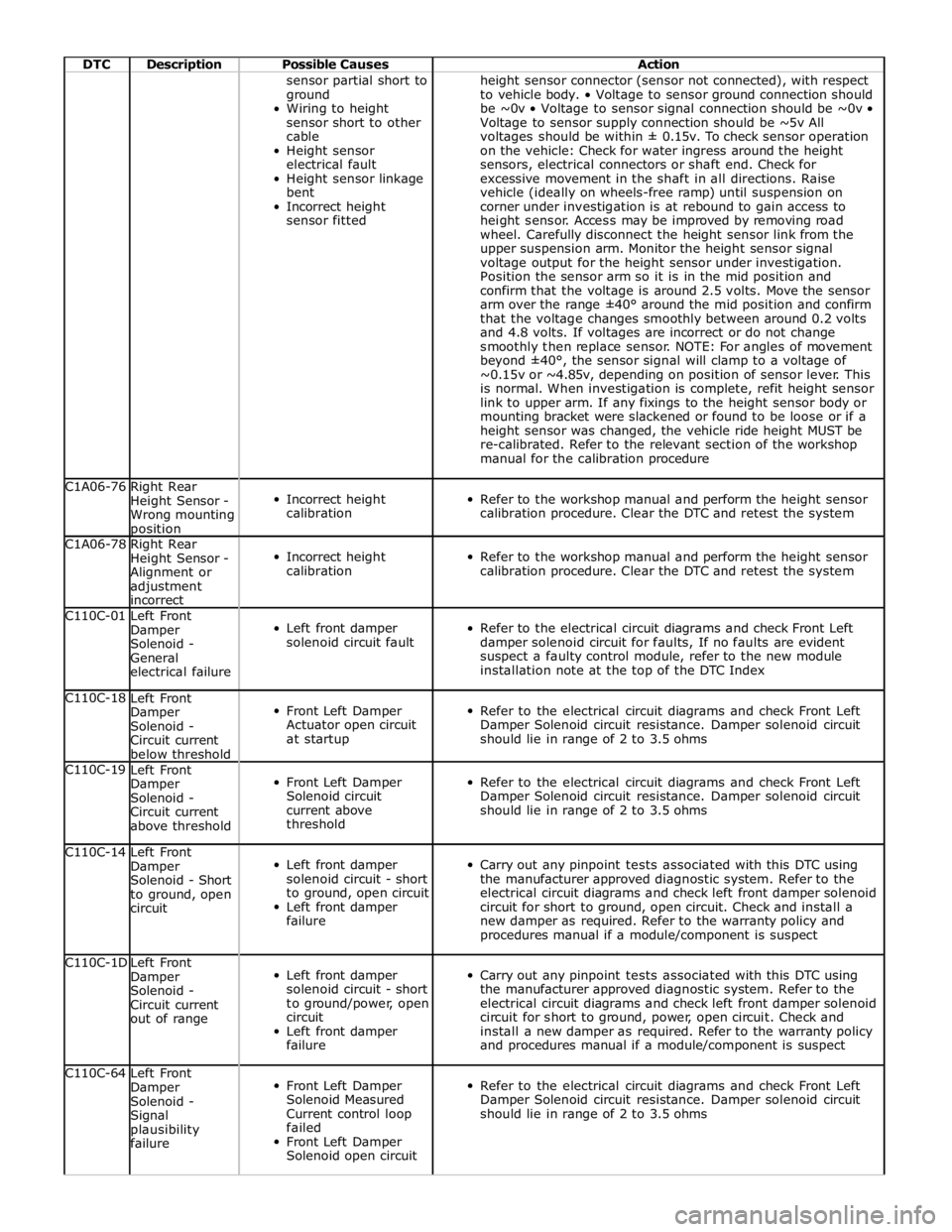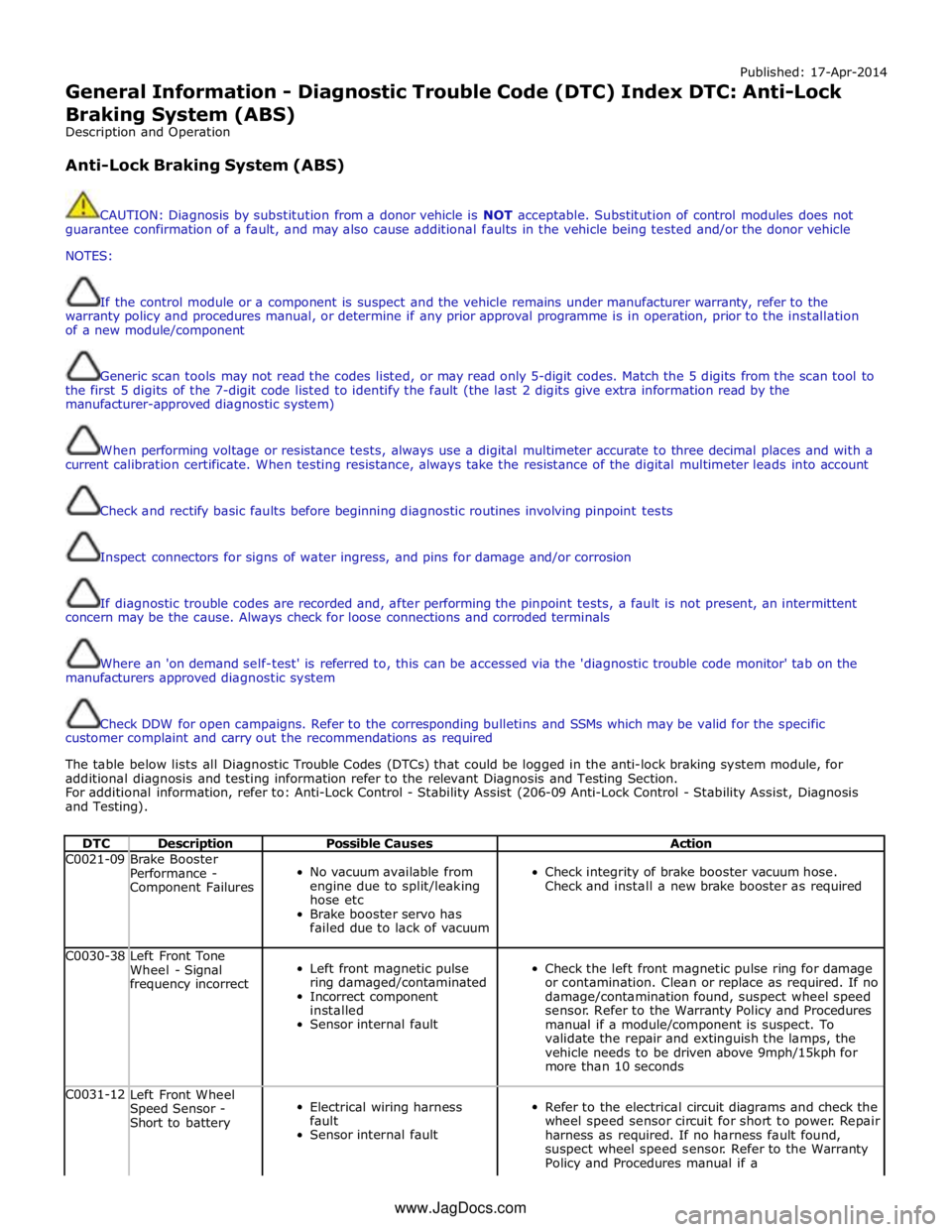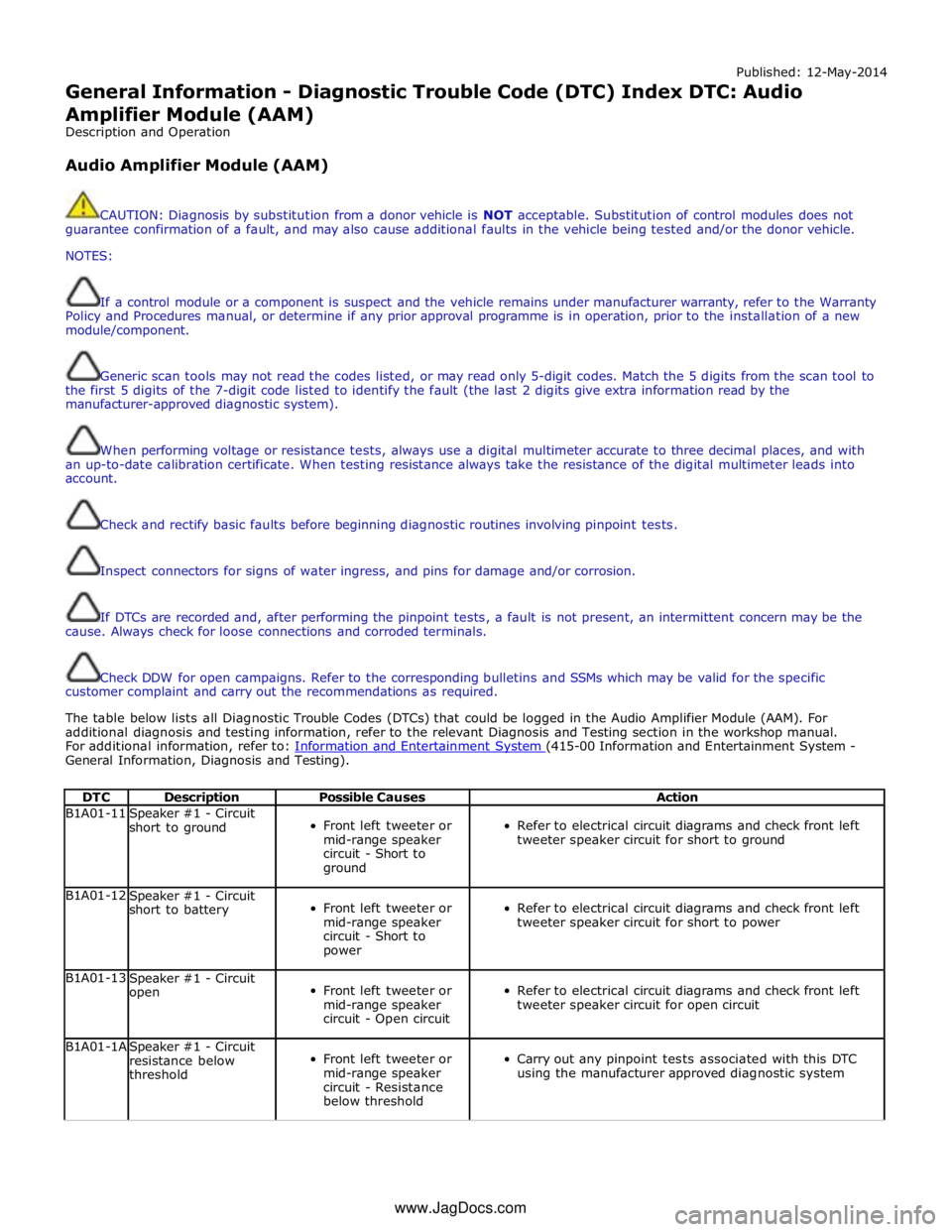pinpoint JAGUAR XFR 2010 1.G Workshop Manual
[x] Cancel search | Manufacturer: JAGUAR, Model Year: 2010, Model line: XFR, Model: JAGUAR XFR 2010 1.GPages: 3039, PDF Size: 58.49 MB
Page 106 of 3039

Published: 17-Apr-2014
General Information - Diagnostic Trouble Code (DTC) Index DTC: Adaptive
Damping Module (SUMB)
Description and Operation
Adaptive Damping Module (SUMB)
CAUTION: Diagnosis by substitution from a donor vehicle is NOT acceptable. Substitution of control modules does not
guarantee confirmation of a fault, and may also cause additional faults in the vehicle being tested and/or the donor vehicle
NOTES:
If the control module or a component is suspect and the vehicle remains under manufacturer warranty, refer to the
warranty policy and procedures manual, or determine if any prior approval programme is in operation, prior to the installation
of a new module/component
Generic scan tools may not read the codes listed, or may read only 5-digit codes. Match the 5 digits from the scan tool to
the first 5 digits of the 7-digit code listed to identify the fault (the last 2 digits give extra information read by the
manufacturer-approved diagnostic system)
When performing voltage or resistance tests, always use a digital multimeter accurate to three decimal places and with a
current calibration certificate. When testing resistance, always take the resistance of the digital multimeter leads into account
Check and rectify basic faults before beginning diagnostic routines involving pinpoint tests
Inspect connectors for signs of water ingress, and pins for damage and/or corrosion
If diagnostic trouble codes are recorded and, after performing the pinpoint tests, a fault is not present, an intermittent
concern may be the cause. Always check for loose connections and corroded terminals
Where an 'on demand self-test' is referred to, this can be accessed via the 'diagnostic trouble code monitor' tab on the
manufacturers approved diagnostic system
Check DDW for open campaigns. Refer to the corresponding bulletins and SSMs which may be valid for the specific
customer complaint and carry out the recommendations as required
he table below lists all diagnostic trouble codes (DTCs) that could be logged in the adaptive damping module, for additional
diagnosis and testing information refer to the relevant diagnosis and testing section
For additional information, refer to: Vehicle Dynamic Suspension (204-05 Vehicle Dynamic Suspension, Diagnosis and Testing).
DTC Description Possible Causes Action C101D-12
Left Front
vertical
acceleration
sensor - Short
to power
Left Front vertical
acceleration sensor
circuit short to power
Refer to the electrical circuit diagrams and check left front
vertical acceleration sensor circuit for short to power or
another circuit. Repair circuit, clear the DTC and retest the
system C101D-14
Left Front
vertical
acceleration
sensor - Short
to ground, open
circuit
Left Front vertical
acceleration sensor
circuit short to
ground, open circuit
Vertical acceleration
sensor fault
Refer to the electrical circuit diagrams and check front vertical
acceleration sensor circuit for short to ground, open circuit. If
no fault found on wiring suspect sensor. Replace sensor, clear
DTC and retest the system C101D-22
Left Front
vertical
acceleration
sensor - Signal
amplitude >
maximum
Left front vertical
acceleration sensor
insecurely mounted
Left front vertical
acceleration sensor
signal circuit short to
another circuit
Left front vertical
acceleration sensor
With vehicle parked on a level surface, read Left Front Vertical
Accelerometer voltage and check it lies in range 1.9 to 2.1
volts. If not OK then check electrical wiring for shorts, loose
connections and repair as required. If wiring OK then suspect
faulty sensor/incorrectly fitted sensor. Check the sensor is
correctly mounted, secure or replace sensor as required. Refer
to the new module/component installation note at the top of
the DTC Index, clear DTC and retest system
Page 114 of 3039

DTC Description Possible Causes Action sensor partial short to
ground
Wiring to height
sensor short to other
cable
Height sensor
electrical fault
Height sensor linkage
bent
Incorrect height
sensor fitted height sensor connector (sensor not connected), with respect
to vehicle body. • Voltage to sensor ground connection should
be ~0v • Voltage to sensor signal connection should be ~0v •
Voltage to sensor supply connection should be ~5v All
voltages should be within ± 0.15v. To check sensor operation
on the vehicle: Check for water ingress around the height
sensors, electrical connectors or shaft end. Check for
excessive movement in the shaft in all directions. Raise
vehicle (ideally on wheels-free ramp) until suspension on
corner under investigation is at rebound to gain access to
height sensor. Access may be improved by removing road
wheel. Carefully disconnect the height sensor link from the
upper suspension arm. Monitor the height sensor signal
voltage output for the height sensor under investigation.
Position the sensor arm so it is in the mid position and
confirm that the voltage is around 2.5 volts. Move the sensor
arm over the range ±40° around the mid position and confirm
that the voltage changes smoothly between around 0.2 volts
and 4.8 volts. If voltages are incorrect or do not change
smoothly then replace sensor. NOTE: For angles of movement
beyond ±40°, the sensor signal will clamp to a voltage of
~0.15v or ~4.85v, depending on position of sensor lever. This
is normal. When investigation is complete, refit height sensor
link to upper arm. If any fixings to the height sensor body or
mounting bracket were slackened or found to be loose or if a
height sensor was changed, the vehicle ride height MUST be
re-calibrated. Refer to the relevant section of the workshop
manual for the calibration procedure C1A06-76
Right Rear
Height Sensor -
Wrong mounting position
Incorrect height
calibration
Refer to the workshop manual and perform the height sensor
calibration procedure. Clear the DTC and retest the system C1A06-78
Right Rear
Height Sensor -
Alignment or
adjustment
incorrect
Incorrect height
calibration
Refer to the workshop manual and perform the height sensor
calibration procedure. Clear the DTC and retest the system C110C-01
Left Front
Damper
Solenoid -
General
electrical failure
Left front damper
solenoid circuit fault
Refer to the electrical circuit diagrams and check Front Left
damper solenoid circuit for faults, If no faults are evident
suspect a faulty control module, refer to the new module
installation note at the top of the DTC Index C110C-18
Left Front
Damper
Solenoid -
Circuit current
below threshold
Front Left Damper
Actuator open circuit
at startup
Refer to the electrical circuit diagrams and check Front Left
Damper Solenoid circuit resistance. Damper solenoid circuit
should lie in range of 2 to 3.5 ohms C110C-19
Left Front
Damper
Solenoid -
Circuit current
above threshold
Front Left Damper
Solenoid circuit
current above
threshold
Refer to the electrical circuit diagrams and check Front Left
Damper Solenoid circuit resistance. Damper solenoid circuit
should lie in range of 2 to 3.5 ohms C110C-14
Left Front
Damper
Solenoid - Short
to ground, open
circuit
Left front damper
solenoid circuit - short
to ground, open circuit
Left front damper
failure
Carry out any pinpoint tests associated with this DTC using
the manufacturer approved diagnostic system. Refer to the
electrical circuit diagrams and check left front damper solenoid
circuit for short to ground, open circuit. Check and install a
new damper as required. Refer to the warranty policy and
procedures manual if a module/component is suspect C110C-1D
Left Front
Damper
Solenoid -
Circuit current
out of range
Left front damper
solenoid circuit - short
to ground/power, open
circuit
Left front damper
failure
Carry out any pinpoint tests associated with this DTC using
the manufacturer approved diagnostic system. Refer to the
electrical circuit diagrams and check left front damper solenoid
circuit for short to ground, power, open circuit. Check and
install a new damper as required. Refer to the warranty policy
and procedures manual if a module/component is suspect C110C-64
Left Front
Damper
Solenoid -
Signal
plausibility
failure
Front Left Damper
Solenoid Measured
Current control loop
failed
Front Left Damper
Solenoid open circuit
Refer to the electrical circuit diagrams and check Front Left
Damper Solenoid circuit resistance. Damper solenoid circuit
should lie in range of 2 to 3.5 ohms
Page 115 of 3039

DTC Description Possible Causes Action C110D-01
Right Front
Damper
Solenoid -
General
electrical failure
Right front damper
solenoid circuit fault
Refer to the electrical circuit diagrams and check Front Right
damper solenoid circuit for faults, If no faults are evident
suspect a faulty control module, refer to the new module
installation note at the top of the DTC Index C110D-18
Right Front
Damper
Solenoid -
Circuit current
below threshold
Front Right Damper
Actuator open circuit
at startup
Refer to the electrical circuit diagrams and check Front Right
Damper Solenoid circuit resistance. Damper solenoid circuit
should lie in range of 2 to 3.5 ohms C110D-19
Right Front
Damper
Solenoid -
Circuit current
above threshold
Front Right Damper
Solenoid circuit
current above
threshold
Refer to the electrical circuit diagrams and check Front Right
Damper Solenoid circuit resistance. Damper solenoid circuit
should lie in range of 2 to 3.5 ohms C110D-14
Right Front
Damper
Solenoid - Short
to ground, open
circuit
Right front damper
solenoid circuit - short
to ground, open circuit
Right front damper
failure
Carry out any pinpoint tests associated with this DTC using
the manufacturer approved diagnostic system. Refer to the
electrical circuit diagrams and check Right front damper
solenoid circuit for short to ground, open circuit. Check and
install a new damper as required. Refer to the warranty policy
and procedures manual if a module/component is suspect C110D-1D
Right Front
Damper
Solenoid -
Circuit current
out of range
Right front damper
solenoid circuit - short
to ground/power, open
circuit
Right front damper
failure
Carry out any pinpoint tests associated with this DTC using
the manufacturer approved diagnostic system. Refer to the
electrical circuit diagrams and check Right front damper
solenoid circuit for short to ground, power, open circuit. Check
and install a new damper as required. Refer to the warranty
policy and procedures manual if a module/component is
suspect C110D-64
Right Front
Damper
Solenoid -
Signal
plausibility
failure
Front Right Damper
Solenoid Measured
Current control loop
failed
Front Right Damper
Solenoid open circuit
Refer to the electrical circuit diagrams and check Front Right
Damper Solenoid circuit resistance. Damper solenoid circuit
should lie in range of 2 to 3.5 ohms C110E-01
Left Rear
Damper
Solenoid -
General
electrical failure
Left Rear damper
solenoid circuit fault
Refer to the electrical circuit diagrams and check Rear Left
damper solenoid circuit for faults, If no faults are evident
suspect a faulty control module, refer to the new module
installation note at the top of the DTC Index C110E-18
Left Rear
Damper
Solenoid -
Circuit current
below threshold
Rear Left Damper
Actuator open circuit
at startup
Refer to the electrical circuit diagrams and check Rear Left
Damper Solenoid circuit resistance. Damper solenoid circuit
should lie in range of 2 to 3.5 ohms C110E-19
Left Rear
Damper
Solenoid -
Circuit current
above threshold
Rear Left Damper
Solenoid circuit
current above
threshold
Refer to the electrical circuit diagrams and check Rear Left
Damper Solenoid circuit resistance. Damper solenoid circuit
should lie in range of 2 to 3.5 ohms C110E-14
Left Rear
Damper
Solenoid - Short
to ground, open
circuit
Left Rear damper
solenoid circuit - short
to ground, open circuit
Left Rear damper
failure
Carry out any pinpoint tests associated with this DTC using
the manufacturer approved diagnostic system. Refer to the
electrical circuit diagrams and check left Rear damper solenoid
circuit for short to ground, open circuit. Check and install a
new damper as required. Refer to the warranty policy and
procedures manual if a module/component is suspect C110E-1D
Left Rear
Damper
Solenoid -
Circuit current
out of range
Left Rear damper
solenoid circuit - short
to ground/power, open
circuit
Left Rear damper
failure
Carry out any pinpoint tests associated with this DTC using
the manufacturer approved diagnostic system. Refer to the
electrical circuit diagrams and check left Rear damper solenoid
circuit for short to ground, power, open circuit. Check and
install a new damper as required. Refer to the warranty policy
and procedures manual if a module/component is suspect C110E-64
Left Rear
Damper
Solenoid -
Signal
Rear Left Damper
Solenoid Measured
Current control loop
Refer to the electrical circuit diagrams and check Rear Left
Damper Solenoid circuit resistance. Damper solenoid circuit
should lie in range of 2 to 3.5 ohms www.JagDocs.com
Page 116 of 3039

DTC Description Possible Causes Action plausibility
failure failed
Rear Left Damper
Solenoid open circuit C110F-01
Right Rear
Damper
Solenoid -
General
Electrical Failure
Right Rear damper
solenoid circuit fault
Refer to the electrical circuit diagrams and check Rear Right
damper solenoid circuit for faults, If no faults are evident
suspect a faulty control module, refer to the new module
installation note at the top of the DTC Index C110F-18
Right Rear
Damper
Solenoid -
Circuit current
below threshold
Rear Right Damper
Actuator open circuit
at startup
Refer to the electrical circuit diagrams and check Rear Right
Damper Solenoid circuit resistance. Damper solenoid circuit
should lie in range of 2 to 3.5 ohms C110F-19
Right Rear
Damper
Solenoid -
Circuit current
above threshold
Rear Right Damper
Solenoid circuit
current above
threshold
Refer to the electrical circuit diagrams and check Rear Right
Damper Solenoid circuit resistance. Damper solenoid circuit
should lie in range of 2 to 3.5 ohms C110F-14
Right Rear
Damper
Solenoid - Short
to ground, open
circuit
Right Rear damper
solenoid circuit - short
to ground, open circuit
Right Rear damper
failure
Carry out any pinpoint tests associated with this DTC using
the manufacturer approved diagnostic system. Refer to the
electrical circuit diagrams and check Right Rear damper
solenoid circuit for short to ground, open circuit. Check and
install a new damper as required. Refer to the warranty policy
and procedures manual if a module/component is suspect C110F-1D
Right Rear
Damper
Solenoid -
Circuit current
out of range
Right Rear damper
solenoid circuit - short
to ground/power, open
circuit
Right Rear damper
failure
Carry out any pinpoint tests associated with this DTC using
the manufacturer approved diagnostic system. Refer to the
electrical circuit diagrams and check Right Rear damper
solenoid circuit for short to ground, power, open circuit. Check
and install a new damper as required. Refer to the warranty
policy and procedures manual if a module/component is
suspect C110F-64
Right Rear
Damper
Solenoid -
Signal
plausibility
failure
Rear Right Damper
Solenoid Measured
Current control loop
failed
Rear Right Damper
Solenoid open circuit
Refer to the electrical circuit diagrams and check Rear Right
Damper Solenoid circuit resistance. Damper solenoid circuit
should lie in range of 2 to 3.5 ohms C1B14-1C
Sensor Supply
Voltage A - Out
of range
Left Front Height
Sensor or Right Front
Height Sensor or Left
Rear Height Sensor or
Right Rear Height
Sensor supply partial
short to other circuit
or ground
Left Front Height
Sensor or Right Front
Height Sensor or Left
Rear Height Sensor or
Right Rear Height
Sensor internal failure
Internal control
module failure
Refer to the electrical circuit diagrams and check sensor
supply for circuit fault. Check all height sensors. Check
module sensor supply output voltage measured voltage
should be between 4.995 volts and 4.85 volts C1B15-1C
Sensor Supply
Voltage B - Out
of range
Left Front Vertical
Acceleration Sensor or
Right Front Vertical
Acceleration Sensor or
Left Rear Vertical
Acceleration Sensor or
Right Rear Vertical
Acceleration Sensor
supply partial short to
other circuit or
ground. Left Front
Vertical Acceleration
Sensor or Right Front
Vertical Acceleration
Refer to the electrical circuit diagrams and check sensor
supply for circuit fault. Check all Vertical Acceleration Sensors.
Check control module sensor supply output voltage Measured
voltage should be between 4.995 volts and 4.85 volts
Page 120 of 3039

Published: 17-Apr-2014
General Information - Diagnostic Trouble Code (DTC) Index DTC: Anti-Lock Braking System (ABS)
Description and Operation
Anti-Lock Braking System (ABS)
CAUTION: Diagnosis by substitution from a donor vehicle is NOT acceptable. Substitution of control modules does not
guarantee confirmation of a fault, and may also cause additional faults in the vehicle being tested and/or the donor vehicle
NOTES:
If the control module or a component is suspect and the vehicle remains under manufacturer warranty, refer to the
warranty policy and procedures manual, or determine if any prior approval programme is in operation, prior to the installation
of a new module/component
Generic scan tools may not read the codes listed, or may read only 5-digit codes. Match the 5 digits from the scan tool to
the first 5 digits of the 7-digit code listed to identify the fault (the last 2 digits give extra information read by the
manufacturer-approved diagnostic system)
When performing voltage or resistance tests, always use a digital multimeter accurate to three decimal places and with a
current calibration certificate. When testing resistance, always take the resistance of the digital multimeter leads into account
Check and rectify basic faults before beginning diagnostic routines involving pinpoint tests
Inspect connectors for signs of water ingress, and pins for damage and/or corrosion
If diagnostic trouble codes are recorded and, after performing the pinpoint tests, a fault is not present, an intermittent
concern may be the cause. Always check for loose connections and corroded terminals
Where an 'on demand self-test' is referred to, this can be accessed via the 'diagnostic trouble code monitor' tab on the
manufacturers approved diagnostic system
Check DDW for open campaigns. Refer to the corresponding bulletins and SSMs which may be valid for the specific
customer complaint and carry out the recommendations as required
The table below lists all Diagnostic Trouble Codes (DTCs) that could be logged in the anti-lock braking system module, for
additional diagnosis and testing information refer to the relevant Diagnosis and Testing Section.
For additional information, refer to: Anti-Lock Control - Stability Assist (206-09 Anti-Lock Control - Stability Assist, Diagnosis
and Testing).
DTC Description Possible Causes Action C0021-09
Brake Booster
Performance -
Component Failures
No vacuum available from
engine due to split/leaking
hose etc
Brake booster servo has
failed due to lack of vacuum
Check integrity of brake booster vacuum hose.
Check and install a new brake booster as required C0030-38
Left Front Tone
Wheel - Signal
frequency incorrect
Left front magnetic pulse
ring damaged/contaminated
Incorrect component
installed
Sensor internal fault
Check the left front magnetic pulse ring for damage
or contamination. Clean or replace as required. If no
damage/contamination found, suspect wheel speed
sensor. Refer to the Warranty Policy and Procedures
manual if a module/component is suspect. To
validate the repair and extinguish the lamps, the
vehicle needs to be driven above 9mph/15kph for
more than 10 seconds C0031-12
Left Front Wheel
Speed Sensor -
Short to battery
Electrical wiring harness
fault
Sensor internal fault
Refer to the electrical circuit diagrams and check the
wheel speed sensor circuit for short to power. Repair
harness as required. If no harness fault found,
suspect wheel speed sensor. Refer to the Warranty
Policy and Procedures manual if a www.JagDocs.com
Page 125 of 3039

Published: 12-May-2014
General Information - Diagnostic Trouble Code (DTC) Index DTC: Audio Amplifier Module (AAM)
Description and Operation
Audio Amplifier Module (AAM)
CAUTION: Diagnosis by substitution from a donor vehicle is NOT acceptable. Substitution of control modules does not
guarantee confirmation of a fault, and may also cause additional faults in the vehicle being tested and/or the donor vehicle.
NOTES:
If a control module or a component is suspect and the vehicle remains under manufacturer warranty, refer to the Warranty
Policy and Procedures manual, or determine if any prior approval programme is in operation, prior to the installation of a new
module/component.
Generic scan tools may not read the codes listed, or may read only 5-digit codes. Match the 5 digits from the scan tool to
the first 5 digits of the 7-digit code listed to identify the fault (the last 2 digits give extra information read by the
manufacturer-approved diagnostic system).
When performing voltage or resistance tests, always use a digital multimeter accurate to three decimal places, and with
an up-to-date calibration certificate. When testing resistance always take the resistance of the digital multimeter leads into
account.
Check and rectify basic faults before beginning diagnostic routines involving pinpoint tests.
Inspect connectors for signs of water ingress, and pins for damage and/or corrosion.
If DTCs are recorded and, after performing the pinpoint tests, a fault is not present, an intermittent concern may be the
cause. Always check for loose connections and corroded terminals.
Check DDW for open campaigns. Refer to the corresponding bulletins and SSMs which may be valid for the specific
customer complaint and carry out the recommendations as required.
The table below lists all Diagnostic Trouble Codes (DTCs) that could be logged in the Audio Amplifier Module (AAM). For
additional diagnosis and testing information, refer to the relevant Diagnosis and Testing section in the workshop manual.
For additional information, refer to: Information and Entertainment System (415-00 Information and Entertainment System - General Information, Diagnosis and Testing).
DTC Description Possible Causes Action B1A01-11
Speaker #1 - Circuit
short to ground
Front left tweeter or
mid-range speaker
circuit - Short to
ground
Refer to electrical circuit diagrams and check front left
tweeter speaker circuit for short to ground B1A01-12
Speaker #1 - Circuit
short to battery
Front left tweeter or
mid-range speaker
circuit - Short to
power
Refer to electrical circuit diagrams and check front left
tweeter speaker circuit for short to power B1A01-13
Speaker #1 - Circuit
open
Front left tweeter or
mid-range speaker
circuit - Open circuit
Refer to electrical circuit diagrams and check front left
tweeter speaker circuit for open circuit B1A01-1A
Speaker #1 - Circuit
resistance below
threshold
Front left tweeter or
mid-range speaker
circuit - Resistance
below threshold
Carry out any pinpoint tests associated with this DTC
using the manufacturer approved diagnostic system www.JagDocs.com
Page 126 of 3039

DTC Description Possible Causes Action B1A01-49
Speaker #1 - Internal
electronic failure
Internal electronic
failure
Suspect the audio amplifier module, check and install a
new module as required, refer to the new
module/component installation note at the top of the
DTC Index B1A02-11
Speaker #2 - Circuit
short to ground
Front right tweeter or
mid-range speaker
circuit - Short to
ground
Refer to electrical circuit diagrams and check front right
tweeter speaker circuit for short to ground B1A02-12
Speaker #2 - Circuit
short to battery
Front right tweeter or
mid-range speaker
circuit - Short to
power
Refer to electrical circuit diagrams and check front right
tweeter speaker circuit for short to power B1A02-13
Speaker #2 - Circuit
open
Front right tweeter or
mid-range speaker
circuit - Open circuit
Refer to electrical circuit diagrams and check front right
tweeter speaker circuit for open circuit B1A02-1A
Speaker #2 - Circuit
resistance below
threshold
Front right tweeter or
mid-range speaker
circuit - Resistance
below threshold
Carry out any pinpoint tests associated with this DTC
using the manufacturer approved diagnostic system B1A02-49
Speaker #2 - Internal
electronic failure
Internal electronic
failure
Suspect the audio amplifier module, check and install a
new module as required, refer to the new
module/component installation note at the top of the
DTC Index B1A03-11
Speaker #3 - Circuit
short to ground
Front left woofer
speaker circuit - Short
to ground
Refer to electrical circuit diagrams and check front left
woofer speaker circuit for short to ground B1A03-12
Speaker #3 - Circuit
short to battery
Front left woofer
speaker circuit - Short
to power
Refer to electrical circuit diagrams and check front left
woofer speaker circuit for short to power B1A03-13
Speaker #3 - Circuit
open
Front left woofer
speaker circuit - Open
circuit
Refer to electrical circuit diagrams and check front left
woofer speaker circuit for open circuit B1A03-1A Speaker #3 - Circuit
Front left woofer
Carry out any pinpoint tests associated with this DTC resistance below threshold speaker circuit - using the manufacturer approved diagnostic system Resistance below threshold B1A03-49
Speaker #3 - Internal
electronic failure
Internal electronic
failure
Suspect the audio amplifier module, check and install a
new module as required, refer to the new
module/component installation note at the top of the
DTC Index B1A04-11
Speaker #4 - Circuit
short to ground
Front right woofer
speaker circuit - Short
to ground
Refer to electrical circuit diagrams and check front right
woofer speaker circuit for short to ground B1A04-12
Speaker #4 - Circuit
short to battery
Front right woofer
speaker circuit - Short
to power
Refer to electrical circuit diagrams and check front right
woofer speaker circuit for short to power B1A04-13
Speaker #4 - Circuit
open
Front right woofer
speaker circuit - Open
circuit
Refer to electrical circuit diagrams and check front right
woofer speaker circuit for open circuit
Page 127 of 3039

DTC Description Possible Causes Action B1A04-1A
Speaker #4 - Circuit
resistance below
threshold
Front right woofer
speaker circuit -
Resistance below
threshold
Carry out any pinpoint tests associated with this DTC
using the manufacturer approved diagnostic system B1A04-49
Speaker #4 - Internal
electronic failure
Internal electronic
failure
Suspect the audio amplifier module, check and install a
new module as required, refer to the new
module/component installation note at the top of the
DTC Index B1A05-11
Speaker #5 - Circuit
short to ground
Rear left speaker
circuit - Short to
ground
Refer to electrical circuit diagrams and check rear left
speaker circuit for short to ground B1A05-12
Speaker #5 - Circuit
short to battery
Rear left speaker
circuit - Short to
power
Refer to electrical circuit diagrams and check rear left
speaker circuit for short to power B1A05-13
Speaker #5 - Circuit
open
Rear left speaker
circuit - Open circuit
Refer to electrical circuit diagrams and check rear left
speaker circuit for open circuit B1A05-1A
Speaker #5 - Circuit
resistance below
threshold
Rear left speaker
circuit - Resistance
below threshold
Carry out any pinpoint tests associated with this DTC
using the manufacturer approved diagnostic system B1A05-49
Speaker #5 - Internal
electronic failure
Internal electronic
failure
Suspect the audio amplifier module, check and install a
new module as required, refer to the new
module/component installation note at the top of the
DTC Index B1A06-11
Speaker #6 - Circuit
short to ground
Rear right speaker
circuit - Short to
ground
Refer to electrical circuit diagrams and check rear right
speaker circuit for short to ground B1A06-12
Speaker #6 - Circuit
short to battery
Rear right speaker
circuit - Short to
power
Refer to electrical circuit diagrams and check rear right
speaker circuit for short to power B1A06-13
Speaker #6 - Circuit
open
Rear right speaker
circuit - Open circuit
Refer to electrical circuit diagrams and check rear right
speaker circuit for open circuit B1A06-1A
Speaker #6 - Circuit
resistance below
threshold
Rear right speaker
circuit - Resistance
below threshold
Carry out any pinpoint tests associated with this DTC
using the manufacturer approved diagnostic system B1A06-49
Speaker #6 - Internal
electronic failure
Internal electronic
failure
Suspect the audio amplifier module, check and install a
new module as required, refer to the new
module/component installation note at the top of the
DTC Index B1A07-11
Speaker #7 - Circuit
short to ground
Rear left surround
speaker circuit - Short
to ground
Refer to electrical circuit diagrams and check rear left
surround speaker circuit for short to ground B1A07-12
Speaker #7 - Circuit
short to battery
Rear left surround
speaker circuit - Short
to power
Refer to electrical circuit diagrams and check rear left
surround speaker circuit for short to power B1A07-13
Speaker #7 - Circuit
open
Rear left surround
speaker circuit - Open
circuit
Refer to electrical circuit diagrams and check rear left
surround speaker circuit for open circuit
Page 128 of 3039

DTC Description Possible Causes Action B1A07-1A
Speaker #7 - Circuit
resistance below
threshold
Rear left surround
speaker circuit -
Resistance below
threshold
Carry out any pinpoint tests associated with this DTC
using the manufacturer approved diagnostic system B1A07-49
Speaker #7 - Internal
electronic failure
Internal electronic
failure
Suspect the audio amplifier module, check and install a
new module as required, refer to the new
module/component installation note at the top of the
DTC Index B1A08-11
Speaker #8 - Circuit
short to ground
Rear right surround
speaker circuit - Short
to ground
Refer to electrical circuit diagrams and check rear right
surround speaker circuit for short to ground B1A08-12
Speaker #8 - Circuit
short to battery
Rear right surround
speaker circuit - Short
to power
Refer to electrical circuit diagrams and check rear right
surround speaker circuit for short to power B1A08-13
Speaker #8 - Circuit
open
Rear right surround
speaker circuit - Open
circuit
Refer to electrical circuit diagrams and check rear right
surround speaker circuit for open circuit B1A08-1A
Speaker #8 - Circuit
resistance below
threshold
Rear right surround
speaker circuit -
Resistance below
threshold
Carry out any pinpoint tests associated with this DTC
using the manufacturer approved diagnostic system B1A08-49
Speaker #8 - Internal
electronic failure
Internal electronic
failure
Suspect the audio amplifier module, check and install a
new module as required, refer to the new
module/component installation note at the top of the
DTC Index B1A09-11
Speaker #9 - Circuit
short to ground
Center speaker circuit
- Short to ground
Refer to electrical circuit diagrams and check center
speaker circuit for short to ground B1A09-12
Speaker #9 - Circuit
short to battery
Center speaker circuit
- Short to power
Refer to electrical circuit diagrams and check center
speaker circuit for short to power B1A09-13
Speaker #9 - Circuit
open
Center speaker circuit
- Open circuit
Refer to electrical circuit diagrams and check center
speaker circuit for open circuit B1A09-1A
Speaker #9 - Circuit
resistance below
threshold
Center speaker circuit
- Resistance below
threshold
Carry out any pinpoint tests associated with this DTC
using the manufacturer approved diagnostic system B1A09-49
Speaker #9 - Internal
electronic failure
Internal electronic
failure
Suspect the audio amplifier module, check and install a
new module as required, refer to the new
module/component installation note at the top of the
DTC Index B1A10-11
Speaker #10 - Circuit
short to ground
Left subwoofer
speaker circuit - Short
to ground
Refer to electrical circuit diagrams and check left
subwoofer speaker circuit for short to ground B1A10-12
Speaker #10 - Circuit
short to battery
Left subwoofer
speaker circuit - Short
to power
Refer to electrical circuit diagrams and check left
subwoofer speaker circuit for short to power B1A10-13
Speaker #10 - Circuit
open
Left subwoofer
speaker circuit - Open
circuit
Refer to electrical circuit diagrams and check left
subwoofer speaker circuit for open circuit
Page 129 of 3039

DTC Description Possible Causes Action B1A10-1A
Speaker #10 - Circuit
resistance below
threshold
Left subwoofer
speaker circuit -
Resistance below
threshold
Carry out any pinpoint tests associated with this DTC
using the manufacturer approved diagnostic system B1A10-49
Speaker #10 -
Internal electronic
failure
Internal electronic
failure
Suspect the audio amplifier module, check and install a
new module as required, refer to the new
module/component installation note at the top of the
DTC Index B1A11-11
Speaker #11 - Circuit
short to ground
Right subwoofer
speaker circuit - Short
to ground
Refer to electrical circuit diagrams and check right
subwoofer speaker circuit for short to ground B1A11-12
Speaker #11 - Circuit
short to battery
Right subwoofer
speaker circuit - Short
to power
Refer to electrical circuit diagrams and check right
subwoofer speaker circuit for short to power B1A11-13
Speaker #11 - Circuit
open
Right subwoofer
speaker circuit - Open
circuit
Refer to electrical circuit diagrams and check right
subwoofer speaker circuit for open circuit B1A11-1A
Speaker #11 - Circuit
resistance below
threshold
Right subwoofer
speaker circuit -
Resistance below
threshold
Carry out any pinpoint tests associated with this DTC
using the manufacturer approved diagnostic system B1A11-49
Speaker #11 -
Internal electronic
failure
Internal electronic
failure
Suspect the audio amplifier module, check and install a
new module as required, refer to the new
module/component installation note at the top of the
DTC Index U2003-98
Fibre Optic
Communication Bus -
Component or system
over temperature
Component or system
over temperature
Clear DTC and allow system to cool, monitor for
re-occurrence of DTC U3000-05
Control module -
System programming
failures
Software
incompatibility
The version of the
Local Configuration
file does not match
that expected
Re-configure the audio amplifier as an existing control
module, using the manufacturer approved diagnostic
system U3000-42
Control module -
General memory
failure
General memory
failure
Re-configure the audio amplifier as an existing control
module, using the manufacturer approved diagnostic
system. Clear DTC, cycle ignition and read DTCs. If DTC
returns, suspect audio amplifier module and install a
new module. Refer to the new module/component
installation note at the top of the DTC Index U3000-44
Control module - Data
memory failure
Data memory failure
Re-configure the audio amplifier as an existing control
module, using the manufacturer approved diagnostic
system. Clear DTC, cycle ignition and read DTCs. If DTC
returns, suspect audio amplifier module and install a
new module. Refer to the new module/component
installation note at the top of the DTC Index U3000-55
Control Module - Not
configured
Incorrect car
configuration data
received
Check/up-date Car Configuration File using manufacturer
approved diagnostic system U3000-87
Control Module -
Missing message
Missing message
Check CJB for DTCs and refer to DTC Index. Check
information and entertainment module for Car
Configuration File and MOST network DTCs and refer to
relevant DTC Index. Carry out MOST/CAN network tests
using the manufacturer approved diagnostic system